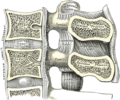Discectomy
(Redirected from Microdiscectomy)
Discectomy is a surgical procedure aimed at removing material from a disc herniation in the spine that is pressing on a nerve root or the spinal cord. The procedure involves the removal of a portion of an intervertebral disc, which allows the herniated or bulging disc material to be removed. This is often performed as a treatment for a herniated disc in the lumbar (lower back) or cervical (neck) regions of the spine. The goal of a discectomy is to relieve pressure on the spinal nerves or spinal cord, thereby alleviating symptoms such as pain, weakness, and numbness.
Indications
Discectomy is typically recommended for patients who have not experienced significant relief from conservative treatments, such as physical therapy, medications, or epidural injections, and who have symptoms that significantly impair their quality of life. Indications for discectomy include:
- Severe pain that limits daily activities
- Nerve damage, as evidenced by weakness, numbness, or loss of bowel or bladder control
- A herniated disc confirmed by imaging studies (e.g., MRI, CT scan) that correlates with the patient's symptomatology
Procedure
Discectomy can be performed using various techniques, including traditional open discectomy, microdiscectomy, and endoscopic discectomy. The choice of technique depends on the specific circumstances of the disc herniation and the surgeon's expertise.
Open Discectomy
In an open discectomy, a larger incision is made in the back, and a significant amount of muscle and bone may be removed to access the herniated disc. This technique allows the surgeon to directly visualize the affected disc and surrounding structures.
Microdiscectomy
Microdiscectomy is a less invasive procedure where the surgeon uses a microscope or magnifying instrument to view the disc and nerves. This allows for a smaller incision and less tissue damage, potentially leading to a quicker recovery.
Endoscopic Discectomy
Endoscopic discectomy involves the use of an endoscope, a small, flexible tube with a camera and light at the end. This technique allows the procedure to be performed through very small incisions, with minimal tissue damage and potentially faster recovery times.
Recovery
Recovery from a discectomy varies depending on the specific procedure performed and the individual patient's condition. Patients may be encouraged to walk and move around within a day after surgery but may need to avoid bending, lifting, or twisting for several weeks. Physical therapy is often recommended to help strengthen the back and improve flexibility.
Risks and Complications
As with any surgical procedure, discectomy carries risks and potential complications. These may include:
- Infection
- Bleeding
- Nerve damage
- Recurrence of disc herniation
- Leakage of spinal fluid
Conclusion
Discectomy is a surgical option for treating herniated discs that have not responded to conservative treatments. It can provide significant relief from pain and other symptoms caused by pressure on the spinal nerves or spinal cord. However, as with any surgery, it is important for patients to discuss the potential risks and benefits with their healthcare provider.
Discectomy
Transform your life with W8MD's budget GLP-1 injections from $125.
W8MD offers a medical weight loss program to lose weight in Philadelphia. Our physician-supervised medical weight loss provides:
- Most insurances accepted or discounted self-pay rates. We will obtain insurance prior authorizations if needed.
- Generic GLP1 weight loss injections from $125 for the starting dose.
- Also offer prescription weight loss medications including Phentermine, Qsymia, Diethylpropion, Contrave etc.
NYC weight loss doctor appointments
Start your NYC weight loss journey today at our NYC medical weight loss and Philadelphia medical weight loss clinics.
- Call 718-946-5500 to lose weight in NYC or for medical weight loss in Philadelphia 215-676-2334.
- Tags:NYC medical weight loss, Philadelphia lose weight Zepbound NYC, Budget GLP1 weight loss injections, Wegovy Philadelphia, Wegovy NYC, Philadelphia medical weight loss, Brookly weight loss and Wegovy NYC
|
WikiMD's Wellness Encyclopedia |
| Let Food Be Thy Medicine Medicine Thy Food - Hippocrates |
Medical Disclaimer: WikiMD is not a substitute for professional medical advice. The information on WikiMD is provided as an information resource only, may be incorrect, outdated or misleading, and is not to be used or relied on for any diagnostic or treatment purposes. Please consult your health care provider before making any healthcare decisions or for guidance about a specific medical condition. WikiMD expressly disclaims responsibility, and shall have no liability, for any damages, loss, injury, or liability whatsoever suffered as a result of your reliance on the information contained in this site. By visiting this site you agree to the foregoing terms and conditions, which may from time to time be changed or supplemented by WikiMD. If you do not agree to the foregoing terms and conditions, you should not enter or use this site. See full disclaimer.
Credits:Most images are courtesy of Wikimedia commons, and templates, categories Wikipedia, licensed under CC BY SA or similar.
Translate this page: - East Asian
中文,
日本,
한국어,
South Asian
हिन्दी,
தமிழ்,
తెలుగు,
Urdu,
ಕನ್ನಡ,
Southeast Asian
Indonesian,
Vietnamese,
Thai,
မြန်မာဘာသာ,
বাংলা
European
español,
Deutsch,
français,
Greek,
português do Brasil,
polski,
română,
русский,
Nederlands,
norsk,
svenska,
suomi,
Italian
Middle Eastern & African
عربى,
Turkish,
Persian,
Hebrew,
Afrikaans,
isiZulu,
Kiswahili,
Other
Bulgarian,
Hungarian,
Czech,
Swedish,
മലയാളം,
मराठी,
ਪੰਜਾਬੀ,
ગુજરાતી,
Portuguese,
Ukrainian
Contributors: Prab R. Tumpati, MD


